Results 1-28 of 28
<<< Previous 1 Next >>>

Bechuana Belle.
W.C. Harris.
[n.d. c.1838.]
Coloured lithograph. 240 x 165mm (9½ x 6½").
Bechuana, people from Tswana; a tribes woman standing bare-breasted with a small child strapped to her back peering up over her shoulder. Tribesmen are seen in the background standing around a wagon. By Sir Captain William Cornwallis Harris (1807-1848), an officer in the Indian army and an acclaimed naturalist who travelled through South Africa. From "Wild Sports of Southern Africa". Abbey 334.
[Ref: 30174] £130.00
(£156.00 incl.VAT)

Bechuana of Distinction.
W.C. Harris del.t
[n.d. c.1838.]
Coloured lithograph. 240 x 165mm (9½ x 6½").
Bechuana, people from Tswana; a tribesman with a loin of meat hanging off of his spear and holding a feather parasol. By Sir Captain William Cornwallis Harris (1807-1848), an officer in the Indian army and an acclaimed naturalist who travelled through South Africa. From "Wild Sports of Southern Africa". Abbey 334.
[Ref: 30173] £130.00
(£156.00 incl.VAT)
![[Ode to Napoleon Bonaparte] Then haste thee to thy sullen Isle, / And gaze upon the sea; / That Element may meet thy smil, It ne'er was ruled by thee. Byron.](img-thumbnail/jpegs/55798.jpg)
[Ode to Napoleon Bonaparte] Then haste thee to thy sullen Isle, / And gaze upon the sea; / That Element may meet thy smil, It ne'er was ruled by thee. Byron.
Drawn & Eng'd by H. Wallis.
[n.d., c.1840.]
Engraving. Sheet 110 x 80mm (4¼ x 3¼") Trimmed as scrap, scuffed and stained.
Napoleon standing on the shore of Elba. Probably a frontispiece to a volumn of Byron's poetry.
[Ref: 55798] £90.00
(£108.00 incl.VAT)
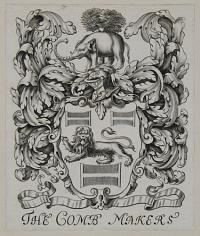
The Comb Makers.
[London, Printed for the Author Rich Wallis Citizen & Arms painter of London & are to be sold by him at his Shop against ye Royall Exchange 1677.]
Engraving. 200 x 155mm, 8 x 6". Trimmed, mounted in album paper.
The arms of the Comb-Makers of London, with three combs, a lion, and an elephant as a reference to their use of ivory. The Company was incorporated by Charles I in 1636. Various craft guilds were established in London as early as the 12th century, later becoming known as City Livery Companies because they often wore a distinctive livery or uniform (although the Comb-makers' Company had no livery or Hall). The companies decided who could work or trade in their crafts, controlling prices and wages, working conditions and welfare. In return for exercising rigorous quality control they received monopoly powers. In continental Europe, various revolutions in the 18th and 19th centuries swept away the guilds, but in England they continued, and several new Companies have appeared in recent years. From "Londons Armory Accuratly delineated in a Graphical display of all the Arms, Crests, Supporters, Mantles and Motto’s of every distinct Company and Corporate Societie in the Honourable City of London".
[Ref: 17849] £75.00
(£90.00 incl.VAT)
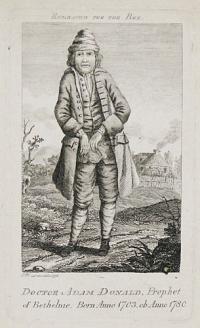
Doctor Adam Donald, Prophet of Bethelnie. Born Anno 1703. ob: Anno 1780. Engraved for The Bee.
J: W,,s [John Williams] ad viv: delint. 1772.
[n.d., 1791]
Rare copper engraving. 145 x 90mm (5¾ x 3½").
Quack doctor Adam Donald (1703-80). Born in Aberdeenshire with disabilities that prevented him from a life of manual labour, his mannerisms, charm, and apparent skills led to his calling as a spiritualist. Donald was called to consult on all matters related to health by the local citizens. A habit of lurking through churchyards ‘speaking’ with the dead fuelled his supernatural legitimacy, while owning several books in other languages (of which he could not speak) contributed to his scholarly image among the townspeople. Prescribing remedies ranging from milk baths to singing on chimneys, he could do no harm. If a death occurred it was the patient’s mistake for not following the ‘Prophet’s’ orders, never Donald’s. While Donald’s wife kept his secret during their marriage, his daughter exposed him as a quack and fraud following his death in 1780.
[Ref: 16193] £120.00
(£144.00 incl.VAT)
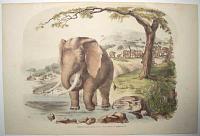
XXII. Elephas Africanus. - The African Elephant.
W. C. Harris del.t
[London, John Murray, n.d., c.1840-3.]
Tinted lithograph with fine hand colour. Printed area 330 x 450mm. (13 x 17¾").
A study of a African Elephant in its natural habitat, with a herd of elephants in the background, from Captain William Cornwallis Harris's 'Portraits of Game and Wild Animals of Southern Africa'. Harris (1807 - 1848), an English military engineer, artist and hunter, joined the East India Company in December 1823. In their employ he was able to pursue his taste for field sports and the depiction of wildlife. One of the more notable of the early Victorian travellers, Harris's illustrations of the large African fauna were the first to have any claim to accuracy. They were originally issued in parts 1840-2 and as a volume in 1843. Abbey Travel 335.
[Ref: 58821] £520.00

Bechuana hunting the Lion.
W.C. Harris.
[n.d. c.1838.]
Coloured lithograph. 165 x 240mm (6½ x 9½").
Bechuana, people from Tswana, seen hunting a lion. By Sir Captain William Cornwallis Harris (1807-1848), an officer in the Indian army and an acclaimed naturalist who travelled through South Africa. From "Wild Sports of Southern Africa". Abbey 334.
[Ref: 30166] £120.00
(£144.00 incl.VAT)

Hunting at Meritsane.
W.C. Harris.
[n.d. c.1838.]
Coloured lithograph. 165 x 240mm (6½ x 9½").
Hunters chasing animals at Meritsane, an area which is now Mokala National Park in the Northern Cape of Africa. By Sir Captain William Cornwallis Harris (1807-1848), an officer in the Indian army and an acclaimed naturalist who travelled through South Africa. From "Wild Sports of Southern Africa". Abbey 334.
[Ref: 30170] £140.00
(£168.00 incl.VAT)

Hunting the Blesbok
W.C. Harris.
[n.d. c.1838.]
Coloured lithograph. 165 x 240mm (6½ x 9½").
A hunter on horse back with his rifle chases after a fleeing herd of blesbuck. By Sir Captain William Cornwallis Harris (1807-1848), an officer in the Indian army and an acclaimed naturalist who travelled through South Africa. From "Wild Sports of Southern Africa". Abbey 334.
[Ref: 30172] £140.00
(£168.00 incl.VAT)

Hunting the Giraffe.
W.C. Harris.
[n.d. c.1838.]
Coloured lithograph. 165 x 240mm (6½ x 9½").
Two Indian army officers on horseback, one in the background with his rifle pointed directly at a giraffe standing still, and a second chasing after an escaping herd. By Sir Captain William Cornwallis Harris (1807-1848), an officer in the Indian army and an acclaimed naturalist who travelled through South Africa. From "Wild Sports of Southern Africa". Abbey 334.
[Ref: 30167] £160.00
(£192.00 incl.VAT)
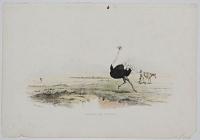
Hunting the Ostrich.
W.C. Harris.
[n.d. c.1838.]
Coloured lithograph. 165 x 240mm (6½ x 9½").
An ostrich in the foreground running as a hunter stands behind by his horse with rifle pointing ready to shoot; in the background a procession of cattle and wagons. By Sir Captain William Cornwallis Harris (1807-1848), an officer in the Indian army and an acclaimed naturalist who travelled through South Africa. From "Wild Sports of Southern Africa". Abbey 334.
[Ref: 30171] £160.00
(£192.00 incl.VAT)

Hunting the Wild Buffalo.
W.C. Harris.
[n.d. c.1838.]
Coloured lithograph. 165 x 240mm (6½ x 9½"). Tear into image along lower edge.
Wild buffalo flee, one injuring itself to left, as Indian hunters arrive on horseback with their rifles ready to shoot. By Sir Captain William Cornwallis Harris (1807-1848), an officer in the Indian army and an acclaimed naturalist who travelled through South Africa. From "Wild Sports of Southern Africa". Abbey 334.
[Ref: 30169] £120.00
(£144.00 incl.VAT)

Shooting the Hippopotamus.
W.C. Harris.
[n.d. c.1838.]
Coloured lithograph. 165 x 240mm (6½ x 9½").
Three hippos seen in the water, a fourth seen walking on the shoreline; an Indian hunter hidden behind a tree ready to shoot. By Sir Captain William Cornwallis Harris (1807-1848), an officer in the Indian army and an acclaimed naturalist who travelled through South Africa. From "Wild Sports of Southern Africa". Abbey 334.
[Ref: 30168] £160.00
(£192.00 incl.VAT)
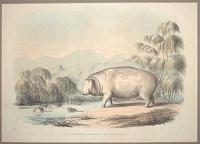
XII. Hippopotamus Amphibius. - The Hippopotamus.
W. C. Harris del.t
[London, John Murray, n.d., c.1840-3.]
Tinted lithograph with hand colour. Printed area 330 x 450mm. (13 x 17¾").
A study of a Hippopotamus in its natural habitat, from Captain William Cornwallis Harris's 'Portraits of Game and Wild Animals of Southern Africa'. Harris (1807 - 1848), an English military engineer, artist and hunter, joined the East India Company in December 1823. In their employ he was able to pursue his taste for field sports and the depiction of wildlife. One of the more notable of the early Victorian travellers, Harris's illustrations of the large African fauna were the first to have any claim to accuracy. They were originally issued in parts 1840-2 and as a volume in 1843. Abbey Travel 335.
[Ref: 30011] £480.00
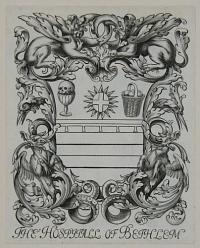
The Hospitall of Bethlem.
[London, Printed for the Author Rich Wallis Citizen & Arms painter of London & are to be sold by him at his Shop against ye Royall Exchange 1677.]
Engraving. 200 x 155mm, 8 x 6". Trimmed, mounted in album paper.
The armorial of Bethlem Hospital, incorporating pairs of dragons and winged lions, and a skull in a goblet. From "Londons Armory Accuratly delineated in a Graphical display of all the Arms, Crests, Supporters, Mantles and Motto’s of every distinct Company and Corporate Societie in the Honourable City of London". Shortly before the publication of this volume, the hospital was moved to a building in Moorfields, which John Evelyn compared to the Tuileries.
[Ref: 17847] £75.00
(£90.00 incl.VAT)
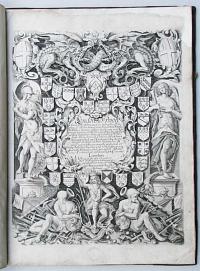
Londons Armory Accuratly delineated in a Graphical display of all the Arms, Crests, Supporters, Mantles and Motto’s of every distinct Company and Corporate Societie in the Honourable City of London....[etc.]
London, Printed for the Author Rich Wallis Citizen & Arms painter of London & are to be sold by him at his Shop against ye Royall Exchange 1677.
Book, folio (458 x 350mm). Engraved titlepage, 27 engraved plates, and original ink and wash sketch of an elaborate empty shield cartouche; broken fine contemporary red calf City of London binding, tooled in gilt. Lacking four preliminary pages. Binding re-cornered, generally scuffed and rubbed, spine worn and partially missing at top, front cover detached. The plates slightly soiled and browned, with waterstains to margins. The titlepage and first two plates with extensive marginal repairs.
A magnificent collection of skillfully rendered crests of the various livery companies of the City of London. Includes East and West India companies, and the Bermudas Company and Merchants of Virginia. Three engravings are full size plates, one with empty shield cartouche at centre. The remainder are arranged as four armorials per plate, separated by contemporary red ruling. Some are annotated in ink by a contemporary hand. Volume also contains Preface and dedication to the Lord Mayor, Sir Thomas Davies. With Worthing Public Library and Phillip Shirley ex-libris bookplates inside front cover, and Worthing ink stamps to upper right of each sheet. See British Library: 138.i.1.
[Ref: 7831] £4,000.00
view all images for this item
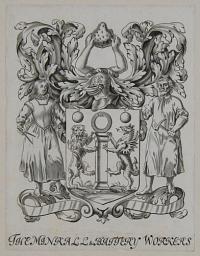
The Minrall & Battery Workers.
[London, Printed for the Author Rich Wallis Citizen & Arms painter of London & are to be sold by him at his Shop against ye Royall Exchange 1677.]
Engraving. 200 x 155mm, 8 x 6". Trimmed, mounted in album paper.
The Company of Mineral and Battery Works was one of two mining monopolies created by Queen Elizabeth I in the 1560s. Various craft guilds were established in London as early as the 12th century, later becoming known as City Livery Companies because they often wore a distinctive livery or uniform. The companies decided who could work or trade in their crafts, controlling prices and wages, working conditions and welfare. In return for exercising rigorous quality control they received monopoly powers. In continental Europe, various revolutions in the 18th and 19th centuries swept away the guilds, but in England they continued, and several new Companies have appeared in recent years. From "Londons Armory Accuratly delineated in a Graphical display of all the Arms, Crests, Supporters, Mantles and Motto’s of every distinct Company and Corporate Societie in the Honourable City of London".
[Ref: 17845] £70.00
(£84.00 incl.VAT)
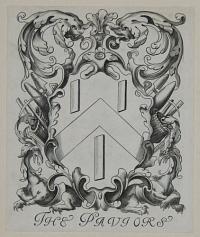
The Paviours.
[London, Printed for the Author Rich Wallis Citizen & Arms painter of London & are to be sold by him at his Shop against ye Royall Exchange 1677.]
Engraving. 200 x 155mm, 8 x 6". Trimmed, mounted in album paper.
The crest of the Pavers company with a pair of gryphons a chevron panel with baskets of pickaxes shovels and spades. In addirion to constructing streets and pavements, the Company was responsible for removing scavenging pigs. Various craft guilds were established in London as early as the 12th century, later becoming known as City Livery Companies because they often wore a distinctive livery or uniform. The companies decided who could work or trade in their crafts, controlling prices and wages, working conditions and welfare. In return for exercising rigorous quality control they received monopoly powers. In continental Europe, various revolutions in the 18th and 19th centuries swept away the guilds, but in England they continued, and several new Companies have appeared in recent years.From "Londons Armory Accuratly delineated in a Graphical display of all the Arms, Crests, Supporters, Mantles and Motto’s of every distinct Company and Corporate Societie in the Honourable City of London".
[Ref: 17856] £70.00
(£84.00 incl.VAT)
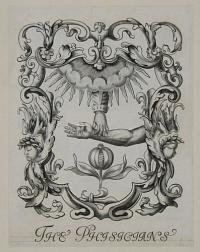
The Phisicians.
[London, Printed for the Author Rich Wallis Citizen & Arms painter of London & are to be sold by him at his Shop against ye Royall Exchange 1677.]
Engraving. 200 x 155mm, 8 x 6". Trimmed, mounted in album paper.
The crest of the College of Physicians (The Royal College from 1674), featuring the taking of a pulse at the wrist, and a pomegranate, symbolising life, fertility and regeneration. From "Londons Armory Accuratly delineated in a Graphical display of all the Arms, Crests, Supporters, Mantles and Motto’s of every distinct Company and Corporate Societie in the Honourable City of London".
[Ref: 17857] £160.00
(£192.00 incl.VAT)
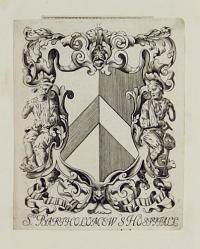
The Hospitall of Bethlem.
[London, Printed for the Author Rich Wallis Citizen & Arms painter of London & are to be sold by him at his Shop against ye Royall Exchange 1677.]
Engraving. 200 x 155mm, 8 x 6". Trimmed, mounted in album sheet with engravings of St Bartholomew's church, hospital and tomb of Rahere in the church on same sheet.
The crest of St Bartholomew's Hospital, the oldest in London, situated in Smithfield. The shield (previously the Coat of Arms used by John Wakering, Master of the Hospital from 1423 to 1462) is flanked by two invalids. From "Londons Armory Accuratly delineated in a Graphical display of all the Arms, Crests, Supporters, Mantles and Motto’s of every distinct Company and Corporate Societie in the Honourable City of London".
[Ref: 37626] £120.00
(£144.00 incl.VAT)
view all images for this item
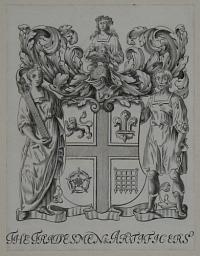
The Tradesmen & Artificers.
[London, Printed for the Author Rich Wallis Citizen & Arms painter of London & are to be sold by him at his Shop against ye Royall Exchange 1677.]
Engraving. 200 x 155mm, 8 x 6". Trimmed, mounted in album paper.
From "Londons Armory Accuratly delineated in a Graphical display of all the Arms, Crests, Supporters, Mantles and Motto’s of every distinct Company and Corporate Societie in the Honourable City of London".
[Ref: 17852] £75.00
(£90.00 incl.VAT)
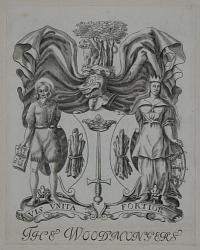
The Woodmongers.
[London, Printed for the Author Rich Wallis Citizen & Arms painter of London & are to be sold by him at his Shop against ye Royall Exchange 1677.]
Engraving. 200 x 155mm, 8 x 6". Trimmed, mounted in album paper.
The arms of the Woodmongers, who brought wood into the City of London for sale. The company became defunct in 1746. Various craft guilds were established in London as early as the 12th century, later becoming known as City Livery Companies because they often wore a distinctive livery or uniform. The companies decided who could work or trade in their crafts, controlling prices and wages, working conditions and welfare. In return for exercising rigorous quality control they received monopoly powers. In continental Europe, various revolutions in the 18th and 19th centuries swept away the guilds, but in England they continued, and several new Companies have appeared in recent years. From "Londons Armory Accuratly delineated in a Graphical display of all the Arms, Crests, Supporters, Mantles and Motto’s of every distinct Company and Corporate Societie in the Honourable City of London".
[Ref: 17848] £75.00
(£90.00 incl.VAT)
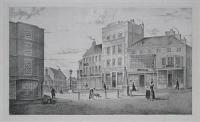
Louth Market Place.
On Stone by T.W. Wallis, Louth.
Printed by W. Monkhouse, York.
Rare lithograph. 250 x 390mm (15¼ x 11½"). Foxing around image and in title area.
The market place in Louth, Lincolnshire.
[Ref: 8794] £160.00
(£192.00 incl.VAT)
![[The Fall of Napoleon.]](img-thumbnail/jpegs/55754.jpg)
[The Fall of Napoleon.]
[Painted by G. Wallis. Engraved by G. Zobel.]
[London, Published Jane 18th 1837, by J. McCormick, 147, Strand.]
Scarce & eare mezzotint. Sheet 320 x 265mm (12½ x 10½"). Trimmed within image, very damage, laid on old paper.
A scene outside the 'Waterloo Tavern' in 'Wellington Street'. A soldier and black figure smile at each other as the soldier trips up an Italian boy carrying on his head a board on which is balanced a statue of Napoleon that is about to crash to the ground. A church can be seen in the background to the right, and posters on the wall of the tavern to the left advertising a gala, 'Anniversary of the Glorious Battle of Waterloo' at Vauxhall Gardens, and a performance of 'The Fall of Napoleon', or 'The Unfortunate Italian' at the Theatre Royal, in celebration of the anniversary of the battle of Waterloo. The original painting is in the Wolverhampton Art Gallery (OP486).
[Ref: 55754] £90.00
(£108.00 incl.VAT)
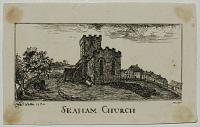
Seaham Church.
Richard Wallis 1784 sculp.
Rare etching. Sheet: 85 x 125mm (3½ x 5''). Trimmed, glue staining in corners.
A view of St Mary's Church in Seaham, County Durham.
[Ref: 50049] £65.00
(£78.00 incl.VAT)
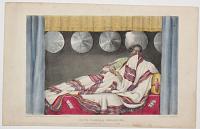
King Sahlela Selassie.
On Stone by W. L. Walton, from a Portrait by Major Harris. Printed by C. Hullmandel.
London Published by Longman & Co. 1844.
Fine hand-coloured lithograph, rare. Sheet: 140 x 220mm (4½ x 8½"). Creasing.
A portrait of Ethiopian Negus (monarch) Shale Selassie (1795-1847). An illustration from William Cornwallis Harris's 'The Highlands of Aethipia' published in three volumes in 1844.
[Ref: 47239] £130.00
(£156.00 incl.VAT)
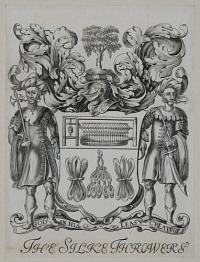
The Silke Throwers.
[London, Printed for the Author Rich Wallis Citizen & Arms painter of London & are to be sold by him at his Shop against ye Royall Exchange 1677.]
Engraving. 200 x 155mm, 8 x 6". Trimmed, mounted in album paper.
The arms of the Silk Weavers of London, with a mulberry tree and two turbaned men. The Silk-throwers were incorporated in 1630 by Charles I under the name of 'the master, wardens, assistants, and commonalty of the trade, art, or mystery of Silkthrowers of the City of London'. Various craft guilds were established in London as early as the 12th century, later becoming known as City Livery Companies because they often wore a distinctive livery or uniform (although the Silk Throwers had no livery or hall). The companies decided who could work or trade in their crafts, controlling prices and wages, working conditions and welfare. In return for exercising rigorous quality control they received monopoly powers. In continental Europe, various revolutions in the 18th and 19th centuries swept away the guilds, but in England they continued, and several new Companies have appeared in recent years.From "Londons Armory Accuratly delineated in a Graphical display of all the Arms, Crests, Supporters, Mantles and Motto’s of every distinct Company and Corporate Societie in the Honourable City of London".
[Ref: 17851] £75.00
(£90.00 incl.VAT)
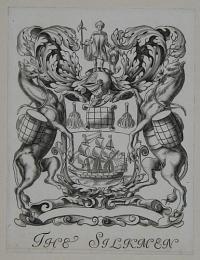
The Silkmen.
[London, Printed for the Author Rich Wallis Citizen & Arms painter of London & are to be sold by him at his Shop against ye Royall Exchange 1677.]
Engraving. 200 x 155mm, 8 x 6". Trimmed, mounted in album paper.
The arms of the Silkmen, incorporated by Charles I in 1631, featuring bales of silk, camels and a merchant ship. Various craft guilds were established in London as early as the 12th century, later becoming known as City Livery Companies because they often wore a distinctive livery or uniform. The companies decided who could work or trade in their crafts, controlling prices and wages, working conditions and welfare. In return for exercising rigorous quality control they received monopoly powers. In continental Europe, various revolutions in the 18th and 19th centuries swept away the guilds, but in England they continued, and several new Companies have appeared in recent years.From "Londons Armory Accuratly delineated in a Graphical display of all the Arms, Crests, Supporters, Mantles and Motto’s of every distinct Company and Corporate Societie in the Honourable City of London".
[Ref: 17862] £95.00
(£114.00 incl.VAT)
<<< Previous 1 Next >>>


![[Ode to Napoleon Bonaparte] Then haste thee to thy sullen Isle, / And gaze upon the sea; / That Element may meet thy smil, It ne'er was ruled by thee. Byron.](img-thumbnail/jpegs/55798.jpg)




















![[The Fall of Napoleon.]](img-thumbnail/jpegs/55754.jpg)



